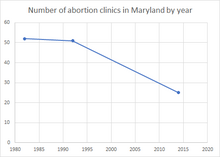Abortion In Maryland
Abortion in Maryland is legal. 64% of adults said in a poll by the Pew Research Center that abortion should be legal in all or most cases.
The number of abortion clinics have been declining in recent years, going from 52 in 1982 to 51 in 1992 to 25 in 2014. Showing a possible movement away from abortion as a solution to unwanted pregnancies.
Terminology
The abortion debate most commonly relates to the "induced abortion" of an embryo or fetus at some point in a pregnancy, which is also how the term is used in a legal sense. Some also use the term "elective abortion", which is used in relation to a claim to an unrestricted right of a woman to an abortion, whether or not she chooses to have one. The term elective abortion or voluntary abortion describes the interruption of pregnancy before viability at the request of the woman, but not for medical reasons.
Anti-abortion advocates tend to use terms such as "unborn baby", "unborn child", or "pre-born child", and see the medical terms "embryo", "zygote", and "fetus" as dehumanizing. Both "pro-choice" and "pro-life" are examples of terms labeled as political framing: they are terms which purposely try to define their philosophies in the best possible light, while by definition attempting to describe their opposition in the worst possible light. "Pro-choice" implies that the alternative viewpoint is "anti-choice", while "pro-life" implies the alternative viewpoint is "pro-death" or "anti-life". The Associated Press encourages journalists to use the terms "abortion rights" and "anti-abortion".
History
Legislative history
By the end of the 1800s, all states in the Union except Louisiana had therapeutic exceptions in their legislative bans on abortions. In the late 1960s and early 1970s, Arkansas, Colorado, Georgia, Maryland, New Mexico, North Carolina and Oregon made reforms to their abortion laws, with most of these states providing more detailed medical guidance on when therapeutic abortions could be performed.
In 2013, state Targeted Regulation of Abortion Providers (TRAP) had provisions related to organization structure, requiring them to be similar to a surgical center in structure. Cities like Baltimore, Austin, and New York passed legislation to require Crisis Pregnancy Centers (CPCs) to disclose their status and that they did not offer abortion services, but organizations representing the CPCs have been successful in courts challenging these laws, principally on the argument that forcing the CPCs to post such language violated their First Amendment rights and constituted compelled speech. Whereas the previous attempts at regulating CPCs in Baltimore and other cities were based on having signage that informed the patient that the CPC did not offer abortion-related services, the FACT Act instead makes the patient aware of state-sponsored services that are available rather than what the CPCs did or did not offer. The law went into effect January 1, 2016. In Maryland in 2013, according to The New York Times, something "rare in this era of polarized abortion politics" occurred when laws that significantly tightened the licensing and inspection of abortion clinics were supported by those on both sides of the abortion issue.
As of 2017, Washington State, New Mexico, Illinois, Alaska, Maryland, Massachusetts, Connecticut, and New Jersey allow qualified non-physicians to prescribe drugs for medical abortions only. In August 2018, the state had a law to protect the right to have an abortion.
As of May 14, 2019, the state prohibited abortions after the fetus was viable, generally some point between week 24 and 28. This period uses a standard defined by the US Supreme Court in 1973 with the Roe v. Wade ruling. Two fetal heartbeat bills have been filed in the Maryland House of Delegates in 2019. On February 8, 2019,Ric Metzgar filed HB 933. On February 8, 2019, Robin L. Grammer, Jr. filed HB 978, a bill entitled "Keep Our Hearts Beating Act." In 2019, Former Maryland House Speaker Michael Busch proposed an amendment to the state's constitution to enshrine the right for women to have an abortion. His replacement Maryland House Speaker Adrienne Jones said she would try to re-introduce the amendment in 2020 in response to the abortion bans in the states of Alabama and Georgia.
Ballot box history
There was a ballot effort in 1992 where Maryland voters codified women's right to have abortions up to viability. They wanted this in place in case Roe v. Wade was ever overturned.
Judicial history
The US Supreme Court's decision in 1973's Roe v. Wade ruling meant the state could no longer regulate abortion in the first trimester.
Clinic history

Between 1982 and 1992, the number of abortion clinics in the state decreased by one, going from 52 in 1982 to 51 in 1992. In 2014, there were 25 abortion clinics in the state. In 2014, 67% of the counties in the state did not have an abortion clinic. That year, 24% of women in the state aged 15 – 44 lived in a county without an abortion clinic. In March 2016, there were ten Planned Parenthood clinics in the state. In 2017, there were nine Planned Parenthood clinics in a state with a population of 1,416,615 women aged 15 – 49 of which five offered abortion services.
Statistics
In the period between 1972 and 1974, there were zero recorded illegal abortion deaths in the state. In 1990, 604,000 women in the state faced the risk of an unintended pregnancy. In 2014, 64% of adults said in a poll by the Pew Research Center that abortion should be legal in all or most cases. In 2017, the state had an infant mortality rate of 6.4 deaths per 1,000 live births.
| Census division and state | Number | Rate | % change 1992–1996 | ||||
|---|---|---|---|---|---|---|---|
| 1992 | 1995 | 1996 | 1992 | 1995 | 1996 | ||
| South Atlantic | 269,200 | 261,990 | 263,600 | 25.9 | 24.6 | 24.7 | –5 |
| Delaware | 5,730 | 5,790 | 4,090 | 35.2 | 34.4 | 24.1 | –32 |
| District of Columbia | 21,320 | 21,090 | 20,790 | 138.4 | 151.7 | 154.5 | 12 |
| Florida | 84,680 | 87,500 | 94,050 | 30 | 30 | 32 | 7 |
| Georgia | 39,680 | 36,940 | 37,320 | 24 | 21.2 | 21.1 | –12 |
| Maryland | 31,260 | 30,520 | 31,310 | 26.4 | 25.6 | 26.3 | 0 |
| North Carolina | 36,180 | 34,600 | 33,550 | 22.4 | 21 | 20.2 | –10 |
| South Carolina | 12,190 | 11,020 | 9,940 | 14.2 | 12.9 | 11.6 | –19 |
| Virginia | 35,020 | 31,480 | 29,940 | 22.7 | 20 | 18.9 | –16 |
| West Virginia | 3,140 | 3,050 | 2,610 | 7.7 | 7.6 | 6.6 | –14 |
Abortion financing

Seventeen states including Maryland use their own funds to cover all or most "medically necessary" abortions sought by low-income women under Medicaid, thirteen of which are required by State court orders to do so. In 2010, the state had 4,352 publicly funded abortions, of which were zero federally funded and 4,352 were state funded.
Abortion rights views and activities

Protests
Women from the state participated in marches supporting abortion rights as part of a #StoptheBans movement in May 2019.
Anti-abortion views and activities
Violence
From February 24–25, 2016, Travis Reynolds, 21, vandalized a Baltimore-area women's health care clinic with anti-abortion graffiti. After being arrested, Reynolds "admitted to police that he defaced the clinic's doors, walls and windows because he thought that it would deter women from using the clinic." Reynolds pleaded guilty in federal court to one count of violating the Freedom of Access to Clinic Entrances Act in October 2016.
Footnotes
- ^ According to the Supreme Court's decision in Roe v. Wade:
Likewise, Black's Law Dictionary defines abortion as "knowing destruction" or "intentional expulsion or removal".(a) For the stage prior to approximately the end of the first trimester, the abortion decision and its effectuation must be left to the medical judgement of the pregnant woman's attending physician. (b) For the stage subsequent to approximately the end of the first trimester, the State, in promoting its interest in the health of the mother, may, if it chooses, regulate the abortion procedure in ways that are reasonably related to maternal health. (c) For the stage subsequent to viability, the State in promoting its interest in the potentiality of human life may, if it chooses, regulate, and even proscribe, abortion except where it is necessary, in appropriate medical judgement, for the preservation of the life or health of the mother.